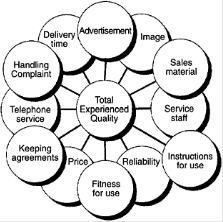SKEDSOFT
Introduction:
Experiences of the customer satisfaction of products and services are essential before improving the satisfaction of the customer. Therefore a system must be created for the continuous measurement, collection and reporting of quality facts.
Types of the measurement:
1. External customers’ satisfaction (CSI=Customer Satisfaction Index).
2. Internal customers’ satisfaction (ESI=Employee Satisfaction Index).
3. Other quality measurements of the firm’s internal processes, often called ‘quality checkpoints’ and ‘quality control points’.
MEASUREMENT OF CUSTOMER SATISFACTION:
- When measuring customers’ satisfaction it is important to realize that the importance of the different quality parameters varies.
- Assuming, therefore, that the customers evaluate the firm on n different dimensions or sub-areas, both as regards the quality of individual areas and the importance of these areas.
- We let the resulting evaluation for the ith subarea be Ci and the associated importance Wi.
- Overall customer satisfaction—the Customer Satisfaction Index, or CSI—can then be calculated as a simple weighted average:
CSI=W1C1 W2C2 … WnCn
MEASURING EMPLOYEE SATISFACTION:
- The internal customer/supplier relationship is all-important in TQM. Being able to satisfy external customers depends on having satisfied internal customers or, as Imai (1986) puts it:
- When you talk about quality, you immediately tend to think about product quality. Nothing could be further from the truth.
- In TQM, the main interest is in ‘human quality’. One of the main control points of ‘human quality’ is employee satisfaction, which should be measured and balanced in the same way as customer satisfaction.

Fig: Total experienced quality
QUALITY CONTROL POINTS AND QUALITY CHECKPOINTS:
- Any firm can be described as a collection of connected processes producing some ‘result’ or other—either input to subsequent processes (the internal customers) or output to external customers.
- We can measure the quality of the result of any process, i.e. ascertain whether we are satisfied with a particular result. When measuring the quality of a process result, it has established a ‘quality control point’.
Total defects per unit = number of defects/number of units produced or tested
- The use of the common metric, Defects per Unit, at last provided a common denominator in all quality discussions.
- It provided a common terminology and methodology in driving the quality improvement process. The definition was the same throughout the company.
- A defect was anything which caused customer dissatisfaction, whether specified or not.
QUALITY COSTS:
Traditionally, so-called quality costs have been divided into the following four main groups:
1. Preventive costs; 2. inspection/appraisal costs; 3. Internal failure costs; 4. External failure costs.